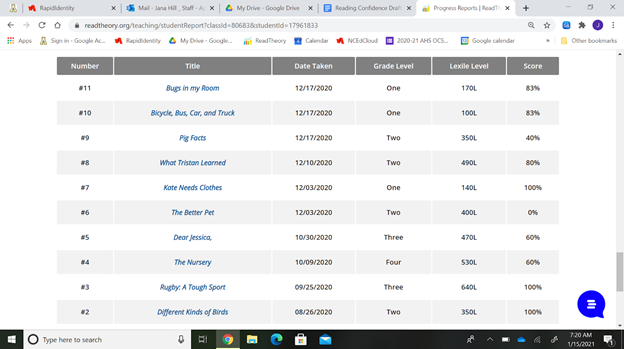3 Strategies to Build Confidence in Under-Performing Students
“I hate to read!” I can’t tell you how many times I have heard this as a Special Education teacher. Some students hate reading because they feel that they are not good at it AND they have no confidence in themselves. Before you can even begin to address their weaknesses, you have to get them to want to read. Activating a student’s interest in reading by showing how a story can come alive is the first step in building confidence.

Strategy 1: It’s Okay to Make Mistakes
Model reading for your students. It is excruciating to see a student get hung up on sounding out a word as they read aloud. By the time they figure out the word, they have lost whatever meaning of the text that they had up to that point. Let your students know it is okay to not know words as they read by modeling what to do when you run across a word you don’t know.
Tip 1: Demonstrate in a read-aloud how to skip the unknown word and use the context to try to figure it out. When my children were young, the Harry Potter books were a huge deal. They were too young to read them on their own, so I read the first one to them. When we first came across the word “muggle”, I had no idea what that meant. I stopped reading, and we tried to figure out the meaning using the context. Lexia Learning has some fun activities to practice using context clues. Silly Sentences is a fun activity that I have used with my students. A variation of this activity can be used by creating a semantic web. I take a passage and replace a word with a nonsense word and write it in the center circle. As the teacher reads the passage, the students add what they know by drawing lines out from the circle and connecting it to the center. This provides a visual representation of how to use context clues to determine the meaning of unknown words.

Tip 2: It’s okay to skip names. Students need to be told this. Names do not always follow phonetic rules. They need to be told not to spend too much time trying to work out the name. Share your own name mishaps when reading. When Harry Potter first came out, people really struggled with the pronunciation of Hemione. My friend’s daughter told me that she loved “Hermie One” in the book! I am guilty of this as well and recently shared this story with my students: Over the winter break, I read a novel in which one of the characters was named “Eoin”. I had never seen that name before. I decided it was pronounced “Ian.” Finally, one day I took the time to look it up and found that it is really pronounced “Owen.” Mispronouncing the character’s name did not interfere with my comprehension of the story. It’s okay to substitute another name and keep reading! If the student’s must know how to say the name, Google “How to pronounce Eoin.” I love that students can now see and hear the correct pronunciation!
Tip 3: When students are reading aloud and come across an unknown word, quietly supply the word so they can keep reading with fluency. Students need to see and hear the word pronounced correctly in order to learn it. For more about the connection between seeing and hearing words Click Here I particularly like that the author pointed out how important it is to have a sense of humor! If your students see you make a mistake and are able to laugh at yourself, they too may not be too frightened to make a mistake.

Strategy 2: Reading is Fun!
Students who don’t like to read may have never experienced the joy of being immersed in a story in such a way that you care about the characters and have to keep reading in order to find out what happens to them. I actively try to find ways to introduce students to the world that can be discovered through reading.
Tip 1: Students of any age like to be read to! That’s why audio books are so popular now. Find a good book, story, poem, song lyrics that tell a story, etc. to hook the student into wanting to know more! Two of my favorites to read to students are “The Tell Tale Heart” by Edgar Allan Poe (https://poestories.com/stories.php) and “In the Cyclops Cave” (an audio recording can be found here on Storynory).
Tip 2: Find a cliffhanger or a story with a twist and save the ending for later. If the students start spontaneously talking about what happens next or begging for more, you’ve got them! Here is a link to a list with 5 cliffhanger stories. You can’t beat O.Henry for a story with a twist. Here’s a dozen short stories by him.

Tip 3: Practice tongue twisters. Tongue twisters can serve a triple purpose. First, who can’t make a mistake when reading one? This is a great way to learn to shrug off a mistake and move on. Full disclosure: I am terrible at reading tongue twisters much to the delight of my students! Second, using tongue twisters is also a way to practice reading aloud in a low pressure environment. They are designed for failure, so everyone fails. Third, tongue twisters can also morph into a vocabulary development lesson because unknown words may need to be defined. You can also develop vocabulary by having students try their hand at writing their own tongue twisters and looking up words that start with the same letters and sounds. I like this one for vocabulary development: A flea and a fly flew up in a flue. Said the flea, “Let us fly!” Said the fly, “Let us flee!” So they flew through a flaw in the flue. Here are 50 to improve pronunciation.
Strategy 3: Practice, Practice, Practice
Practice will not only get you to Carnegie Hall; it improves reading performance in students. I tell my student that old joke:
A man on the street in NY stops to ask directions, “How do you get to Carnegie Hall?”
A man answers, “Practice, practice, practice.”
After I explain what the joke means, I also explain that’s the only way to become a better reader.

Tip 1: Paired reading. Collaborative Strategic Reading (CSR) is a way for students to enhance comprehension skills by using strategies before, during, and after reading a passage. This strategy could be used as a paired reading or in a small group cooperative setting. I have used this program with a group of Autistic high school students, and I opted to use it in a paired reading setting as my other goals were to encourage both students to communicate with each other and improve social skills. This is a structured program and its implementation should be modeled and taught before letting students try it on their own. The CSR strategies are: (1) preview the text, (2) click and clunk, (3) get the gist, and (4) wrap up. For more information, Check out this article on Edutopia.
When I used CSR with my students, I used Read Theory data to pair students with similar reading abilities. Once the students have learned the protocol, they can work together on reading passages based on their reading levels. Read Theory provides paper reading passages by grade level which can be found here. You can also use this technique with supplemental reading activities that correspond with science or social studies lessons.
Tip 2: Immediate Feedback. The adaptive component of Read Theory’s reading comprehension practice automatically matches a student’s reading ability level with text in order for them to be successful. My favorite aspect of Read Theory’s program is that it “self-adjusts.” As students become more proficient, higher level passages are added. If they struggle, they go back to the previous level where they have success. As a result, students can practice their reading comprehension skills AND get immediate feedback–not days later when they have forgotten what they have read. The “adjustable” nature of the program helps keep the students motivated without increasing their frustration level.
Here’s a screenshot that shows how a student’s levels go up and down as they work through the program:

Growing Self Confident Readers
Self-Confidence in reading should be cultivated in reluctant readers. Plant seeds to spark interest and water with engaging materials. Continue to feed by teaching strategies and letting students know that it is okay to make mistakes. No one knows all the words all the time. Continue to grow the skills through practice and by actively teaching strategies. Then harvest the fruit of your labor–a student who has built up their confidence and wants to work on their weaknesses so they can read more!
For more strategies and tips, check out Strategies and Tips from Real Teachers and Four Comprehension Skills Every Student Needs.



